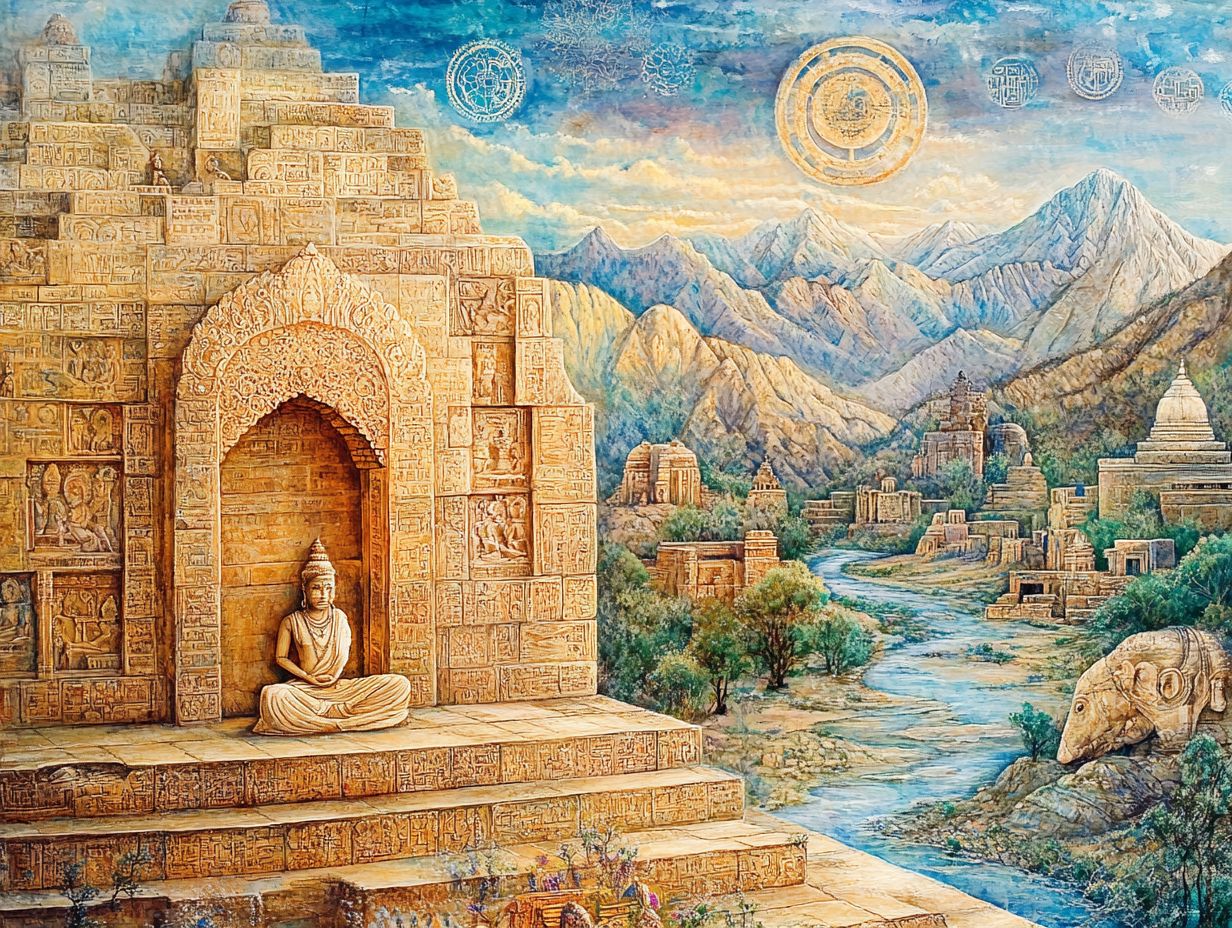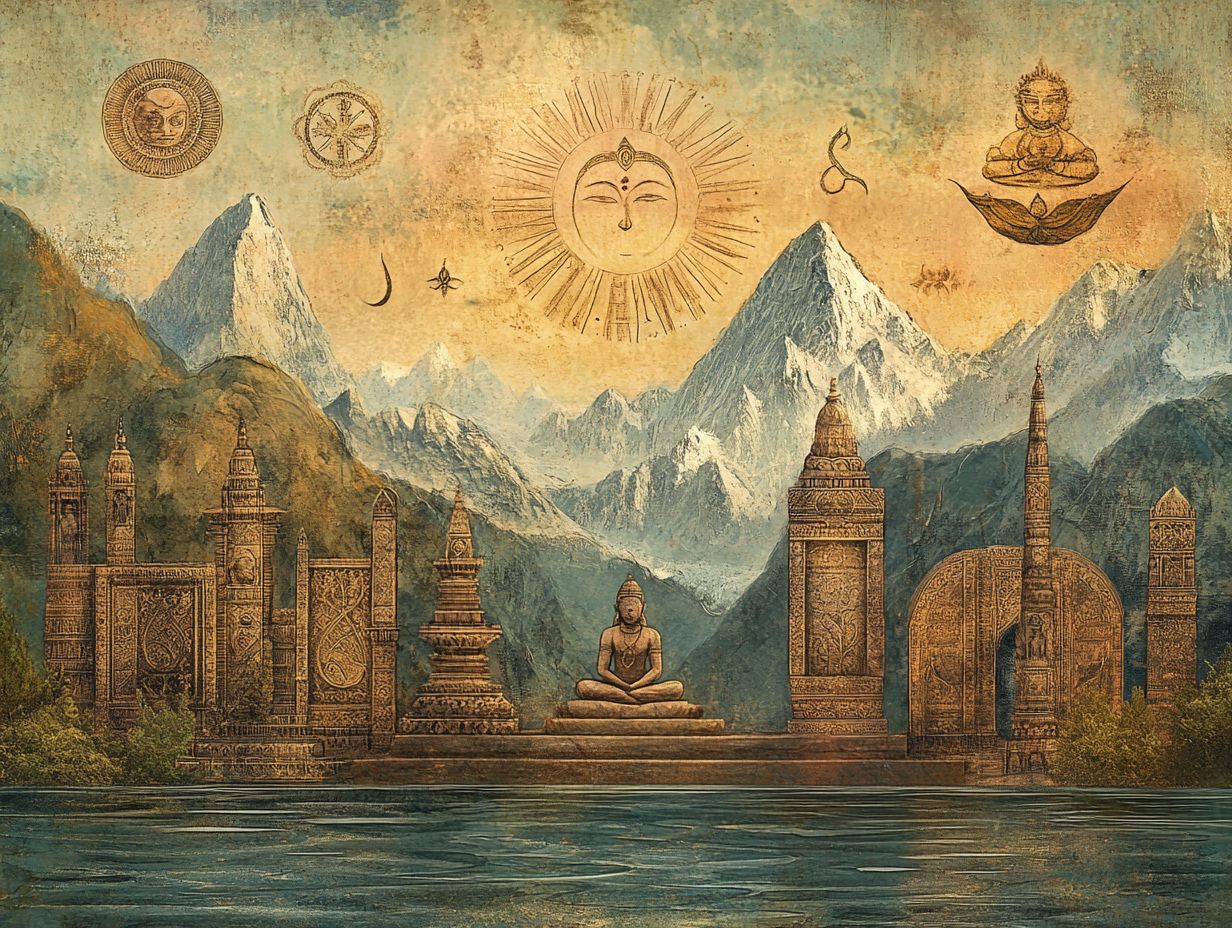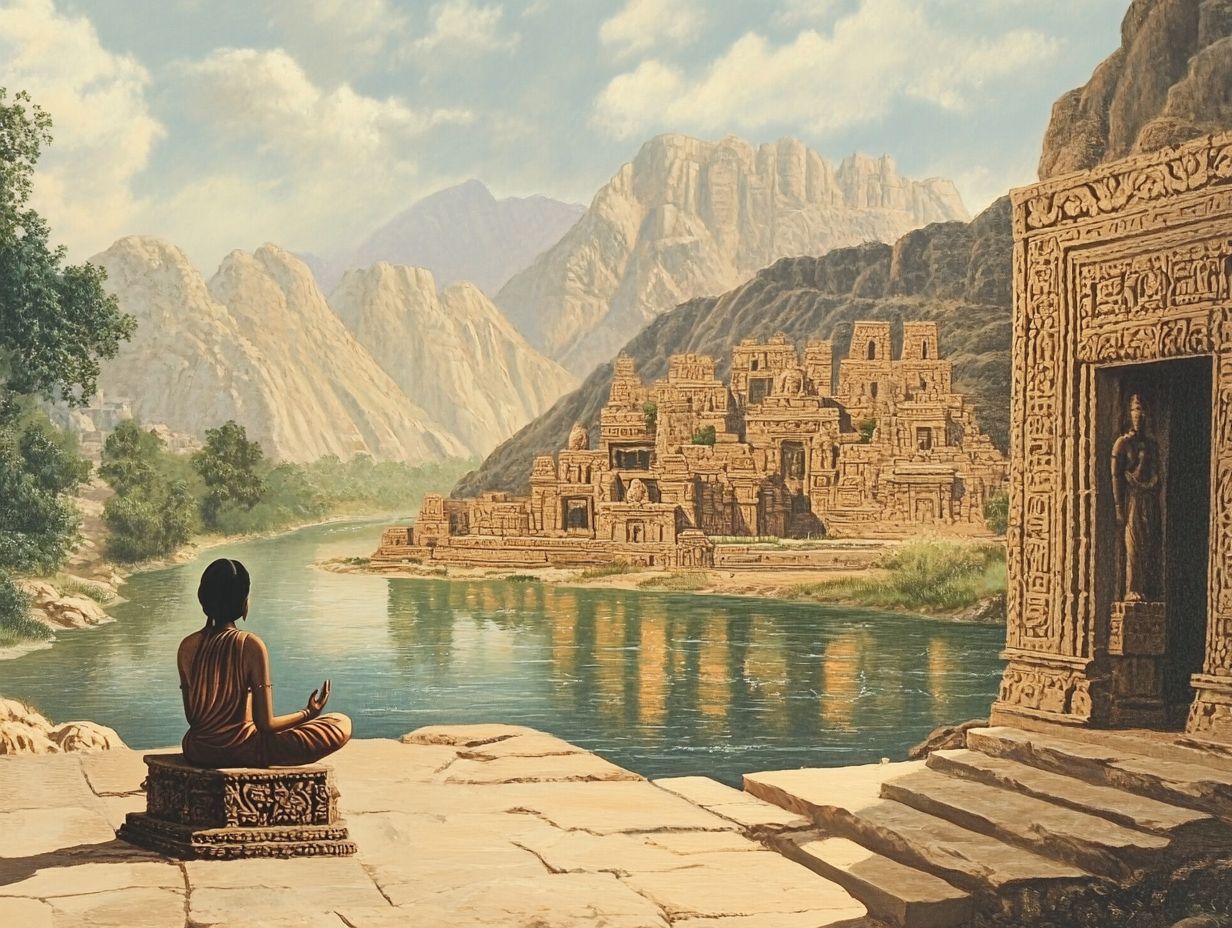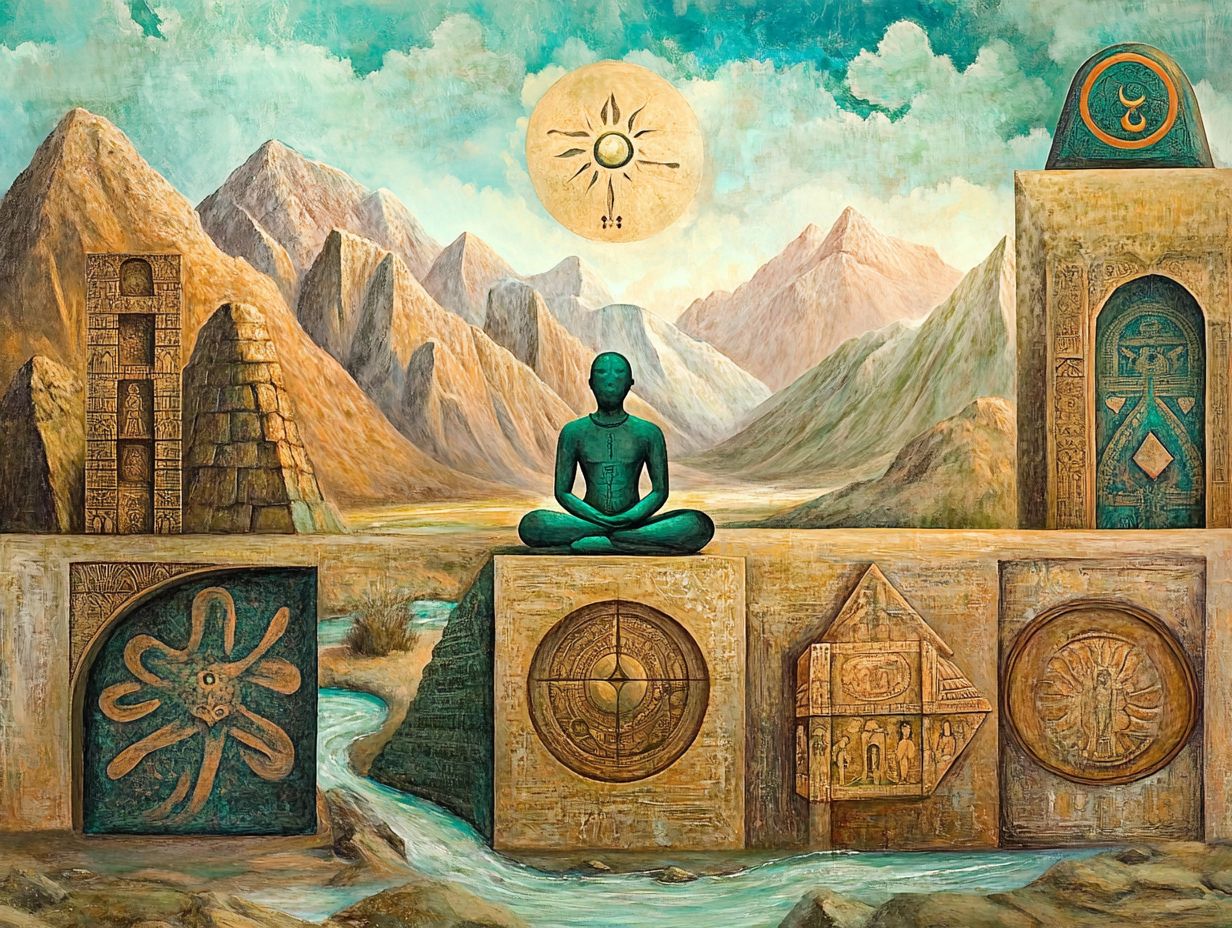Indus Valley Traditions Combined With What Other Religion to Form the Foundations of Early Hinduism?
Hinduism, recognized as one of the world’s oldest religions, presents a rich tapestry intricately woven from a multitude of traditions and influences. This exploration delves into the origins of Hinduism, tracing its roots back to the ancient Indus Valley Civilization and highlighting how these early traditions laid the foundation for this vibrant faith. The historical significance of these ancient traditions sheds light on the diverse cultural synthesis that characterizes Hinduism today.
The article reveals the significant contributions of the Vedic religion, Brahmanism, Jainism, and Buddhism, illustrating how these diverse elements converged to shape the early religious beliefs and practices of Hinduism. This convergence underscores the cultural exchange and religious pluralism that have been integral to the development of Hinduism.
This fascinating journey of spiritual evolution invites one to uncover the complexities and nuances that define this enduring religion. The integration of ancient traditions and spiritual practices highlights the dynamic nature of Hinduism.
What is Hinduism?

Hinduism stands as one of the world’s oldest religions, intricately woven into the spiritual fabric of the Indian subcontinent and encompassing a diverse spectrum of beliefs, rituals, and traditions. The historical evolution of this religion reflects its deep roots in the cultural identity and sacred geography of the region.
This ancient faith is distinguished by its rich array of sacred texts, notably the Vedic literature, which eloquently conveys its philosophical insights, ethical teachings, and mythological narratives. The Vedic culture and its sacred chants have profoundly influenced Hinduism’s spiritual heritage.
Furthermore, Hinduism’s historical landscape reveals a tapestry of cultural influences from various traditions, including indigenous beliefs and the syncretic practices that have developed over millennia. This blend of local customs and ancient traditions underscores the religion’s historical development.
This reflects a dynamic spiritual evolution that continues to inform and shape the faith in contemporary times.
What is the Origin of Hinduism?
The origins of Hinduism can be traced back to the early Vedic civilization, which emerged around 1500 BCE with the arrival of the Indo-Aryans in the Indian subcontinent. This marked a significant period defined by the composition of the Vedic texts, which serve as the bedrock of early Hindu philosophy, rituals, and spiritual practices.
During this transformative era, the arrival of the Indo-Aryans interacted with the diverse cultures already present in the region, particularly the Dravidian societies. This interaction led to a rich synthesis of ideas and practices that not only influenced the religious landscape but also shaped social structures and languages, laying the groundwork for subsequent developments in Hinduism. The Aryan migration played a crucial role in this cultural synthesis, fostering a blend of religious beliefs and ritualistic behavior.
The Vedic texts, esteemed for their spiritual insights, began to reflect this dynamic interplay, with hymns and rituals adapting to local traditions and beliefs. Over time, these foundational elements evolved into an intricate tapestry of rituals, philosophies, and deities defining early Hinduism, all while adapting to the cultural milieu of ancient India. The integration of ancestral traditions and ritual purity further enriched the evolving religious framework.
What are the Indus Valley Traditions?
The Indus Valley civilization, widely recognized as the Harappan culture, thrived around 2500 BCE in the northwestern regions of South Asia. This remarkable civilization is distinguished by its advanced urban planning, extensive trade networks, and innovative agricultural practices, as well as its rich spiritual traditions that would significantly shape the evolution of Hinduism. The civilization’s achievements in metallurgy, pottery, and arts and crafts highlight its sophisticated cultural identity and historical significance.
Archaeological evidence reveals a complex social structure, illuminated by a variety of religious symbols and artifacts that reflect indigenous beliefs and rituals centered on nature worship, meditation, and communal gatherings. These findings provide insight into the early spiritual practices and the philosophy of life that guided the civilization.
What is the Indus Valley Civilization?
The Indus Valley Civilization, recognized as one of the earliest urban cultures in the world, is celebrated for its remarkable urban planning. Cities such as Mohenjo-Daro and Harappa exemplify this sophistication, featuring meticulously organized layouts, advanced drainage systems, and a flourishing economy bolstered by extensive trade networks, all of which significantly contribute to its lasting legacy. The urban civilization’s achievements in architecture and city planning underscore its innovative engineering prowess.
The urban design of this civilization reveals a profound understanding of city planning, characterized by grid-like street configurations and impressive architectural elements that showcase their innovative engineering prowess. Archaeological findings indicate that these cities boasted sanitation systems that were remarkably advanced for their era, reflecting a high level of civic responsibility among their inhabitants. The emphasis on ritualistic behavior and communal living further highlights the civilization’s sophisticated social structure.
Moreover, artifacts unearthed in trade hubs highlight a vibrant economy, with goods exchanged across distant regions, illustrating not only local craftsmanship but also an impressive capacity for cultural exchange. The societal advancements of the Indus Valley Civilization are evident in its rich cultural heritage, which continues to influence modern communities today. The civilization’s historical context is crucial for understanding its enduring impact on contemporary cultural and social practices.
What are the Key Features of Indus Valley Traditions?
The key features of Indus Valley traditions reveal a profound emphasis on rituals, spiritual practices, and the use of religious symbols, illustrating a rich tapestry of belief systems that reflect the civilization’s deep connection with both nature and the divine.
These practices encompassed various ceremonies dedicated to honoring deities, prominently featuring sacred artifacts such as figurines and seals adorned with intricate carvings. Spirituality emerged through the frequent incorporation of nature-inspired motifs and symbols, underscoring the inhabitants’ reverence for essential elements like water and fertility. These fertility rituals and water worship practices reflect a deep connection with the divine and the natural world.
The diverse rituals likely served not only to foster community bonds but also to facilitate individuals’ quests for spiritual enlightenment. Archaeological evidence indicates that fire altars and offerings held crucial significance within their belief system, reinforcing the role of ritualism in expressing devotion and seeking blessings from higher powers. These practices highlight the importance of communal living and the integration of spiritual practices in daily life.
How did Indus Valley Traditions Influence Hinduism?

The traditions of the Indus Valley significantly influenced the spiritual and cultural foundations of early Hinduism, introducing elements of religious syncretism that exemplify the blending of indigenous beliefs with nascent Hindu practices. This transition to Hinduism reflects a deep historical evolution and integration of various religious influences.
This intricate synthesis would gradually evolve over centuries, ultimately giving rise to a diverse and enriched religious framework.
What are the Similarities between Indus Valley Traditions and Hinduism?
The similarities between Indus Valley traditions and Hinduism reveal a fascinating tapestry of rituals, spiritual practices, and belief systems that underscore a remarkable continuity in worship. This includes a shared veneration for nature and a deep respect for deities, elements that are intrinsic to both cultures.
Such shared characteristics imply a profound connection that stretches across millennia, illustrating how ancient practices have not only evolved but have also preserved fundamental aspects. The striking parallels in ceremonial activities such as the use of fire in rituals and the offering of food and flowers to deities underscore a significant reverence for the natural world.
Both cultures emphasize the ideals of purity and cleanliness in their spiritual practices, reflecting a mutual understanding of the importance of both physical and mental cleanliness for spiritual well-being. This continuity invites a deeper exploration into how these early traditions may have shaped the development of Hinduism as it is recognized today, effectively bridging the ancient and modern spiritual landscapes.
What are the Differences between Indus Valley Traditions and Hinduism?
While notable similarities exist between the traditions of the Indus Valley and Hinduism, significant differences emerge, particularly in the evolution of philosophical concepts, the formalization of scriptures, and the establishment of the caste system that characterizes later Hindu society. The development of Hindu deities and the establishment of sacred spaces such as temples also highlight these differences.
The social fabric of the Indus Valley civilization appeared to be more egalitarian, placing emphasis on trade, agricultural advancements, and urban planning, all without the rigid hierarchical structure typical of Hinduism. In contrast, the development of Hinduism saw the emergence of a more defined stratification, epitomized by the caste system, which categorized individuals into specific social roles. The religious hierarchy and the formalization of ethical values also distinguish later Hindu society from its ancient predecessors.
Whereas Indus traditions leaned heavily on symbols and artifacts, Hinduism cultivated a vast corpus of texts, including the Vedas and Upanishads, that articulated complex philosophical ideas and spiritual practices. The oral traditions and textual traditions of Hinduism further established its rich spiritual heritage.
These distinctions underscore the significant divergence in philosophical and societal frameworks over time.
What Other Religions Contributed to the Formation of Early Hinduism?
The emergence of early Hinduism was not a solitary event; it represented a rich confluence of diverse religious influences. This intricate tapestry included elements from the Vedic religion and Brahmanism, as well as significant contributions from Jainism and Buddhism, all of which collectively enriched the spiritual landscape of ancient India. This cultural exchange and integration of beliefs played a crucial role in the historical evolution of Hinduism.
What is the Influence of Vedic Religion on Hinduism?
The Vedic religion, distinguished by its sacred scriptures known as the Vedas, played a pivotal role in shaping Hinduism. It introduced essential rituals, cosmological concepts, and ethical teachings that became the bedrock of this ancient faith. The belief in reincarnation, samsara, karma, and dharma as metaphysical concepts were also integral to this development.
The Vedas, comprised of four primary texts, not only delineate various sacrificial rituals but also illuminate the importance of living in harmony with the cosmos. Within these texts, the hymns and mantras function as spiritual guides, underscoring the significance of dharma righteous living. This foundational understanding gradually evolved into more intricate spiritual practices, as evidenced in later writings such as the Upanishads and the Puranas, which delve deeper into philosophical inquiries and the notion of karma. These sacred texts created a cultural synthesis that remains influential.
As these components were woven into the fabric of Hinduism, they cultivated a rich tapestry of beliefs and practices that continue to inform contemporary rituals, resonating with millions around the globe today. Important historical narratives and religious texts shaped these traditions.
What is the Impact of Brahmanism on Hinduism?

Brahmanism, which emerged as a prominent religious system in ancient India, profoundly influenced Hinduism by underscoring the pivotal role of the Brahmins as spiritual leaders and the paramount importance of Vedic rituals. This framework not only shaped the social structure but also established the practices of the Hindu community and reinforced the caste system.
In this religious context, society was organized into a hierarchy, with the Brahmins occupying the highest echelons due to their scholarly prowess and ritualistic expertise. This positioning allowed them to wield significant influence over social norms and cultural values. The emphasis on Vedic rituals delineated distinct roles within the community, leading to a nuanced interplay between spiritual authority and societal responsibilities. Over time, these elements contributed to the consolidation of diverse traditions within Hinduism, while simultaneously presenting challenges as various groups sought both recognition and autonomy. Religious pluralism began to emerge as part of this complex social structure.
The rituals, often revered as sacred, became foundational to the religious experience, reinforcing the enduring significance of Brahmanism in shaping contemporary Hindu practices and spiritual heritage.
How did Jainism and Buddhism Contribute to the Development of Hinduism?
Jainism and Buddhism have played pivotal roles in shaping the development of Hinduism, introducing alternative belief systems and philosophies that challenged established practices. These traditions emphasized key principles such as non-violence, karma, and spiritual liberation, resonating deeply with a wide array of followers. Their influence is an example of the cultural exchange that has shaped religious evolution.
Not only did they highlight the significance of ethical living, but they also inspired a profound introspection regarding the self and its relationship with the cosmos. Emerging during a period of substantial religious evolution, these faiths offered new avenues for spiritual fulfillment that diverged from traditional rituals, promoting a shift toward internal devotion over external observance.
The impact of Jainism and Buddhism is evident in the evolution of certain doctrines within Hinduism, particularly the integration of concepts like ahimsa, or non-violence, which became central to various schools of thought. The dialogues between these philosophies wove a rich tapestry of beliefs, fostering an environment where spirituality transcended rigid dogmas, embracing diverse interpretations and practices. This integration highlights the religious pluralism within Hinduism.
How Did Early Hinduism Evolve and Develop?
The early evolution of Hinduism was marked by substantial transformation and growth, shaped by interactions with a variety of cultural and religious influences. This intricate interplay culminated in the establishment of diverse spiritual practices and philosophies, showcasing a historical continuity that reflects the dynamic nature and adaptability of Hinduism throughout the ages. The historical significance of these transformations is profound.
What are the Major Texts and Scriptures of Hinduism?
The major texts and scriptures of Hinduism, including the Vedic texts, Upanishads, and the epics such as the Mahabharata and Ramayana, serve as foundational sources of spiritual knowledge and ethical teachings. Composed in sacred languages, these texts have profoundly influenced the religious and philosophical landscape of the faith. These sacred texts are a testament to the integration of beliefs within Hinduism.
These venerated works encapsulate a rich tapestry of beliefs and practices while offering profound insights into the nature of existence, the cosmos, and the self. The Vedic texts, regarded as the oldest scriptures, provide rituals and hymns that forge a connection between devotees and the divine. In contrast, the Upanishads explore essential philosophical concepts, such as Brahman and Atman, fostering a deeper understanding of the interconnectedness of all living beings.
The Mahabharata and Ramayana go beyond mere storytelling; they impart vital moral lessons, emphasizing dharma, or righteousness, which serves as a guiding principle for individuals in their daily lives. Collectively, these texts form a comprehensive framework that continues to inspire and educate millions, shaping the spiritual journey of countless seekers. They also serve as key religious texts containing ethical values and mythology.
What are the Key Beliefs and Practices of Early Hinduism?
The foundational beliefs and practices of early Hinduism were intricately woven around the concepts of dharma, karma, and the cycle of reincarnation. Rituals and spiritual exercises were meticulously designed to align individuals with their ethical duties and the divine order governing the universe. The historical development of these practices is crucial to understanding their significance.
At the heart of this ancient faith lies the principle of dharma, which advocates for living in harmony with the universal moral order. This principle guides individual actions in accordance with their responsibilities and roles within society. Each person’s dharma is distinct, shaped by factors such as age, caste, and life circumstances, serving as a pathway to righteousness.
Karma, the unwavering law of cause and effect, ensures that every action carries consequences that influence one’s present and future existences. The cycle of reincarnation, or samsara, further underscores the significance of righteous living, as souls are reborn into various forms based on their past actions.
Rituals and offerings are pivotal in this spiritual framework, facilitating connections with deities and the spiritual realm, thus deepening one’s commitment to these essential beliefs. These rituals form a key part of the community festivals and worship practices within the religion.
How did Hinduism Adapt and Change over Time?

Hinduism has exhibited remarkable adaptability and transformation throughout its history, shaped by a myriad of historical contexts, cultural interactions, and the integration of diverse practices and beliefs. This dynamic evolution has enabled it to thrive as a vibrant religion across the centuries and highlights its rich cultural heritage.
The origins of this evolution can be traced back to ancient times, with the Vedic texts serving as the bedrock of spiritual thought. Over the centuries, these foundational texts absorbed various philosophical influences and local traditions, creating a rich tapestry of belief. Significant historical events, such as the emergence of Buddhism and Jainism, prompted reinterpretations within Hindu beliefs, highlighting a remarkable willingness to evolve rather than resist change. These events mark essential points in the religious beliefs and spiritual practices of Hinduism.
Moreover, encounters with Islamic and colonial cultures introduced new ideas and practices, further enriching this multifaceted faith. Over time, Hinduism has embraced reform movements, such as the Bhakti and Arya Samaj, which redefined the concepts of devotion and social engagement. These movements have allowed the religion to resonate with contemporary values while still honoring its profound and diverse traditions. The historical context of these changes is vital to understanding their impact.
Frequently Asked Questions
What are the Indus Valley traditions and how did they influence the foundations of early Hinduism?
Indus Valley traditions refer to the cultural practices and beliefs of the ancient Indus Valley Civilization, which flourished in the Indian subcontinent from 3300 BCE to 1300 BCE. These ancient traditions played a significant role in the development of early Hinduism, as many of the practices and beliefs were assimilated into the religion. The historical significance of these traditions is profound.
Which other religion combined with Indus Valley traditions to form the foundations of early Hinduism?
The Indus Valley traditions combined with Vedic religion, which originated in the Indo-Gangetic Plain around 1500 BCE, to form the foundations of early Hinduism. This fusion of beliefs and practices led to the development of the Vedic-Hindu culture, which still influences modern Hinduism. The Aryan migration played a role in this cultural synthesis, forming a rich spiritual heritage.
How did the Indus Valley traditions contribute to the development of Hinduism?
The Indus Valley traditions played a crucial role in shaping early Hinduism by introducing elements such as worship of mother goddesses, reverence for sacred animals, and rituals of fire worship. These traditions were also incorporated into the Vedic religion, leading to the birth of Hinduism. The ancient traditions included iconography and symbolism that permeated early religious beliefs.
What are some specific examples of Indus Valley traditions that were incorporated into Hinduism?
One example is the worship of the mother goddess, which was prevalent in the Indus Valley Civilization and is still a central aspect of Hinduism. Another example is the practice of yoga, which originated in the Indus Valley and is now a widely recognized tradition in Hinduism. These ancient traditions also included communal living and ancestor worship.
Did the Indus Valley traditions and Vedic religion merge seamlessly to form Hinduism?
No, the merger of Indus Valley traditions and Vedic religion was not a smooth process. There were conflicts and debates between the two cultures, but over time, they found common ground and fused together to form the foundations of early Hinduism. This integration involved significant cultural exchange and adaptation.
Are there any remnants of Indus Valley traditions still present in modern Hinduism?
Yes, many elements of Indus Valley traditions can still be found in modern Hinduism. For example, the worship of mother goddesses and reverence for sacred animals are still prevalent, and the practice of yoga is widely accepted as a form of spiritual and physical exercise. The early religion of the Indus Valley has influenced ancient traditions and Vedic culture, particularly through spiritual practices and ritualistic behavior. Archaeological findings suggest a rich cultural synthesis and complex social structure, which included sacred texts, polytheism, and animism. The transition to Hinduism from these roots involved the integration of beliefs and religious evolution, marked by communal living and the development of religious texts and sacred spaces.
